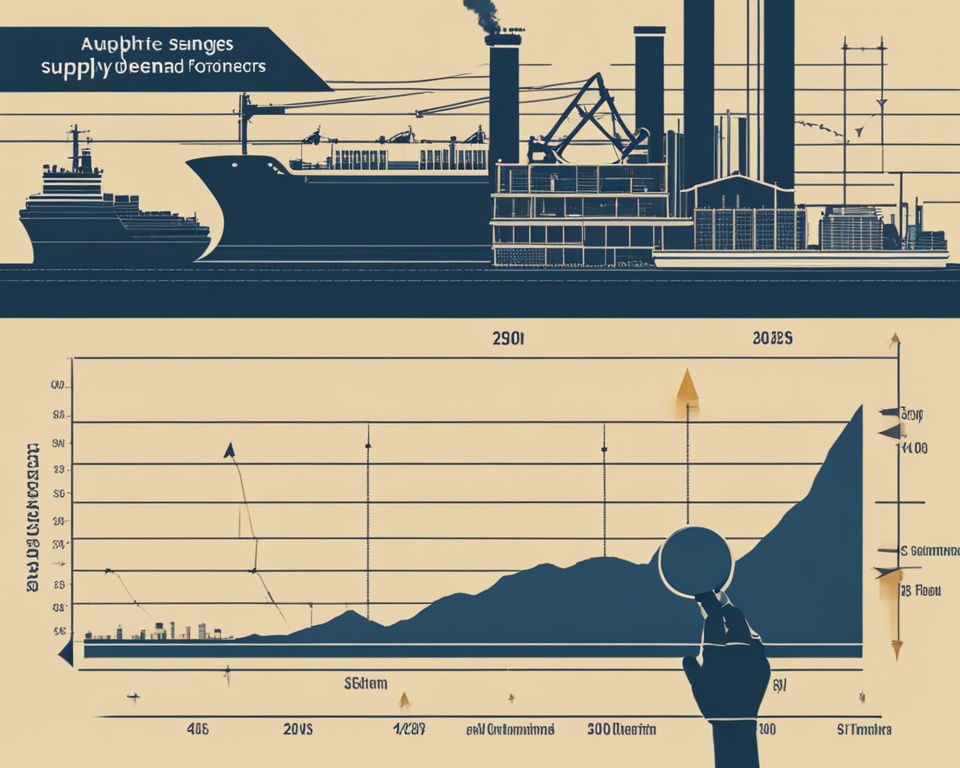Have you ever thought about why some companies are so efficient in managing their supply chains? In today’s fast business world, it’s key to make supply chain processes smoother. That’s where SAP SCM comes in. It helps companies improve logistics, manage inventory better, and make smarter procurement choices. I’ll explore how SAP SCM boosts business operations and what makes it a top choice for today’s companies.
Key Takeaways
- SAP SCM is crucial for enhancing efficiency in Supply Chain Management.
- Streamlining supply chain processes can lead to sustainable competitive advantages.
- Logistics optimization and inventory management are pivotal elements of SAP SCM.
- Implementing SAP SCM can improve procurement strategies significantly.
- A comprehensive understanding of SAP SCM allows businesses to adapt to market changes rapidly.
Understanding Supply Chain Management
Exploring supply chain management shows us its key principles for success. It’s all about making sure different parts like buying, making, shipping, and logistics work together well. This way, goods and services move smoothly from suppliers to customers.
Knowing how supply chain processes work is key for companies wanting to get better. Every step in the chain plays a big role in how well a company does. It helps cut costs and make customers happy. A well-run supply chain can boost productivity and help a company make more money.
To show why these processes matter, I’ve made a table with the main parts of supply chain management:
| Component | Description | Impact on Business |
|---|---|---|
| Procurement | Acquisition of goods and services | Cost savings and supplier relationships |
| Production | Manufacturing and assembly of products | Quality control and efficient processes |
| Distribution | Transportation and logistics management | Timely delivery and customer satisfaction |
| Logistics | Management of the flow of goods | Reduced lead times and inventory costs |
What is SAP SCM?
SAP SCM, or SAP supply chain management, is a powerful software. It helps businesses make their supply chain better. With SAP, companies can see and control their supply chain better, making things run smoother.
This tool lets companies track data in real-time. This means they can easily keep an eye on inventory and how well the supply chain is doing. Working with suppliers and partners gets easier too, thanks to better communication tools.
SAP SCM is great at connecting with other SAP products. This gives a full view of how a business runs. For example, working with Ariba can make buying things better. This helps with making quick, smart decisions and running things more efficiently.
Using SAP SCM has many benefits. It helps businesses stay ahead in a fast market. It helps manage changes in demand, make logistics smoother, and keep inventory in check.
In short, SAP SCM is key for any business wanting to improve its supply chain. For more on how to make your business better with SAP ERP, check out this resource.
Benefits of SAP SCM
The Benefits of SAP SCM are many, offering big advantages for supply chain operations. SAP supply chain management gives companies a clear view of their supply chain. This helps in making better decisions and tracking goods in real-time. It makes the supply chain work more efficiently.
One big plus of advantages of SAP supply chain management is better forecasting. Being able to predict sales accurately means less extra stock and fewer stockouts. This is key in today’s fast market.

With SAP SCM, operations get a big boost in efficiency. Companies can make processes smoother, automate tasks, and better manage their vendors. These changes lead to big cost cuts and save time, which is crucial to stay ahead in a tough market.
To show the benefits more clearly, I’ve put together a table below:
| Benefit | Description |
|---|---|
| Enhanced Visibility | Real-time tracking and visibility into operations across the supply chain. |
| Improved Forecasting | Accurate demand forecasts reduce waste and optimize inventory levels. |
| Operational Efficiency | Streamlined processes lead to greater productivity and reduced costs. |
| Cost Savings | Lower operational costs through optimized workflows and vendor relationships. |
| Time Efficiency | Faster processes improve response times and overall performance. |
Using tools like Ariba Supplier Collaboration can boost these benefits even more. This cloud-based platform helps improve supplier relationships. It makes procurement processes more efficient. Businesses using SAP SCM can see big, lasting changes that help them stand out in the market.
Logistics Optimization in SAP SCM
In today’s fast-paced world, making logistics better is key to a smooth supply chain. SAP SCM helps companies plan better for transportation. This means better routes and lower costs. Using smart logistics plans helps track important performance signs, making the supply chain quicker to respond.
Starting to make logistics better in SAP SCM means knowing the key numbers. These numbers are:
- Transportation costs per unit
- Delivery reliability
- Transit times
- Warehouse efficiency
Keeping an eye on these numbers helps companies make smart choices. With SAP SCM, companies can make their transport routes better. This cuts down on time and makes service better.
For companies wanting to improve their buying and logistics, checking out SAP Ariba Modules could be helpful. These modules help work better with suppliers and make decisions based on data. They work well with SAP SCM’s logistics plans.
By focusing on logistics optimization in SAP SCM, companies can make their operations smoother. They can quickly adjust to new market needs. This leads to success in managing their supply chains over time.
Inventory Management Techniques
Effective inventory management is key to a successful supply chain. Using SAP for inventory management boosts efficiency and cuts costs. Just-in-time inventory is a top method, delivering products as needed to reduce storage costs. It helps keep inventory low while making sure products are always available.
ABC analysis is another great technique. It sorts inventory into A, B, and C classes based on value and quantity. Class A items are valuable and few, while Class C items are cheap but many. Focusing on Class A items helps me manage inventory better and improve service levels. This targeted approach makes inventory optimization easier and uses SAP’s features well.
Also, a good safety stock management plan is crucial. It helps businesses handle unexpected demand without running out of stock. By figuring out the right safety stock amount based on past data and demand changes, I can balance inventory and keep customers happy.
These techniques make operations smoother, increase profits, and boost customer satisfaction. Learning these strategies with SAP inventory management can make a supply chain more flexible and quick to respond.
Demand Forecasting Strategies
Accurate demand forecasting is key to managing supply chains well. It helps predict market needs and manage inventory better. SAP demand forecasting uses advanced methods to improve forecasting accuracy.
There are many ways to predict demand accurately. Time-series forecasting looks at past data to spot trends and patterns. It uses stats to forecast based on what happened before. Causal forecasting looks at how things like ads or economic trends affect demand.
Using past sales data is vital for better forecasting. It helps me see buying habits and adjust my forecasts. Combining data with advanced methods makes forecasts more reliable, helping me make better supply chain decisions.
SAP demand forecasting tools give me real-time data. This helps me fine-tune my forecasting strategies. With SAP, I can keep up with supply chain changes. As I get better at forecasting, I can cut inventory, save money, and meet customer needs better.

Transportation Planning with SAP SCM
Transportation planning is key to making supply chains work better. SAP SCM helps businesses run smoother. It uses advanced analytics to find the best routes and ways to move goods. This way, companies can plan for the future by looking at past data.
Using SAP SCM also makes working with carriers better. Everyone involved gets real-time updates and can talk more easily. This leads to smarter decisions that improve delivery times and keep costs down.
Here’s a table that shows how SAP SCM helps with transportation planning:
| Feature | Traditional Planning | SAP SCM Transportation |
|---|---|---|
| Route Optimization | Manual adjustments | Automated suggestions based on data |
| Cost Efficiency | Higher operational costs | Reduced costs through analytics |
| Delivery Performance | Inconsistent delivery times | Improved reliability and performance |
| Carrier Collaboration | Lack of engagement | Real-time updates and communication |
Using SAP SCM for transportation planning boosts logistics performance. It helps businesses meet their customer needs better.
Understanding Warehouse Operations
Warehouse operations are key to the supply chain’s success. Using SAP SCM warehouse management boosts efficiency in warehousing. Automation helps track inventory accurately and cuts down on mistakes. This makes processes smoother and more efficient.
Important parts of good warehouse operations include:
- Automated Inventory Tracking: This keeps stock levels right, giving real-time updates.
- Optimized Picking Processes: Better picking means faster order fulfillment and fewer mistakes.
- Effective Space Utilization: Arranging products well uses space better, cuts costs, and improves workflow.
Improving these areas makes warehousing efficiency better. This leads to a more agile supply chain that meets customer needs well. Looking into SAP SCM warehouse management, I see its big role in making warehouses and supply chains work better.
Effective Procurement Strategies
Using smart procurement strategies can make supply chains work better. In my work with SAP SCM procurement, I’ve found key things that make the buying process successful. Building strong relationships with suppliers is key. It builds trust and makes sure products get delivered on time. Choosing the right vendors is also crucial for meeting company goals.
Managing costs is vital for sustainable procurement plans. With SAP SCM, I can look at purchase data to find ways to cut costs without lowering quality. Knowing what’s happening in the market helps me negotiate better deals and save money over time.
- Supplier Relationship Management: Working closely with suppliers can improve cooperation and bring new ideas.
- Data-Driven Insights: Using analytics in SAP SCM gives me the info I need to make smart choices.
- Flexible Procurement Models: Changing procurement plans to fit market needs makes us quick and adaptable in finding what we need.
These strategies work together to make procurement strong and effective. Every choice we make affects the whole supply chain. This shows how important it is to plan and act strategically.

Enhancing Supplier Collaboration
Working well with suppliers is key to a smooth supply chain. Using SAP SCM for supplier management has really helped me. It makes communication better, tracks performance well, and helps with planning together.
SAP SCM is great at making things clear and getting suppliers involved. I can share important info like demand forecasts and stock levels online. This makes suppliers more responsive, which means better quality, lower costs, and faster delivery.
| Collaboration Strategy | Description | Benefits |
|---|---|---|
| Regular Check-Ins | Scheduled meetings to discuss performance metrics and upcoming needs. | Builds trust and aligns goals. |
| Shared Planning Tools | Utilization of cloud-based platforms for real-time planning and updates. | Enhances agility and minimizes surprises. |
| Performance Metrics | Establishing clear KPIs to measure supplier performance. | Improves accountability and drives continuous improvement. |
| Sustainable Practices | Incorporating sustainability criteria into supplier evaluations. | Strengthens brand reputation and meets consumer demands. |
Using these strategies in SAP SCM has made working with suppliers better. Real examples show big improvements and cost cuts. For more info, check out this resource on supplier collaboration. Working together well with suppliers brings big benefits to my supply chain.
Order Fulfillment Best Practices
Order fulfillment is key to keeping customers happy and running smoothly. By using best practices, you can make the SAP SCM order management better. Here are some strategies that can change how you fulfill orders:
- Demand-driven order processing: Knowing what customers want is crucial. Using predictive analytics helps match inventory with sales. This cuts down on wait time and boosts service quality.
- Real-time tracking: Showing customers where their orders are builds trust. This can be done by adding new tech to your order systems.
- Effective communication: Keeping teams in the loop helps speed up the process. Regular updates and feedback stop mistakes and delays.
Automation tools are also key to making fulfillment faster. They handle the boring tasks, letting people focus on making customers happy. Using a smart Procure-to-Pay (P2P) process cuts down on mistakes with invoices and payments. This makes fulfilling orders better overall.
Leveraging Supply Chain Analytics
In today’s fast-paced world, using supply chain analytics is key for any business wanting to get better and perform well. With SAP SCM analytics, companies get insights that help make better decisions. This helps them keep getting better by spotting trends, finding what’s not working, and seeing where they can grow.
Key performance indicators (KPIs) are very important for checking how well supply chains work. They let us see if we’re doing well and point out what needs work. By using SAP SCM analytics tools, I can make reports in real-time. This helps me make decisions based on data, keeping me ahead in the market.

To get the most out of supply chain analytics, I suggest doing the following:
- Find KPIs that match your company’s goals.
- Use strong reporting tools in SAP SCM to look at data well.
- Use analytics to watch how your supply chain is doing and find ways to make it better.
- Make a team culture that values making decisions based on data.
Getting good insights from supply chain analytics can really change how you make big decisions. It leads to better running of operations. By always making things better with data, you can have a supply chain that quickly adapts to new market needs.
| Benefit | Description |
|---|---|
| Informed Decision-Making | Using data means choices are based on real facts, not just guesses. |
| Operational Efficiency | Analytics help businesses make processes smoother and cut down on waste. |
| Trend Identification | Analytics show patterns that can help shape future plans. |
| Continuous Improvement | Insights from data push for ongoing betterment of supply chain ways. |
SAP SCM Implementation Steps
Starting SAP SCM implementation needs key steps for a smooth transition. First, set clear goals. This means saying what you aim to achieve, like better efficiency or improved inventory control.
Then, plan your project. A detailed roadmap helps sort tasks, timelines, and resources. This planning is crucial for tackling challenges during implementation.
It’s important to involve stakeholders in SAP SCM implementation. Good communication makes sure everyone knows the goals, their roles, and the perks. This builds a strong team commitment.
Training is crucial too. Every team member must know how to use the new system well. Training should include both technical skills and best practices to use the system fully.
Even with good planning, challenges can come up, like data issues or resistance to change. Facing these challenges proactively and with stakeholder input can help overcome them.
To sum up the key steps for SAP SCM implementation:
- Define objectives
- Plan the project
- Engage stakeholders
- Provide thorough training
Following these steps and using industry best practices is key for SAP SCM implementation success.
How to Choose the Right SAP SCM Solution
Choosing SAP SCM needs a deep look at what your business needs. It’s smart to check several important factors before deciding. First, think about how the software will grow with your business.
How the software works is key. Make sure it has the right tools for managing inventory, predicting demand, and working with suppliers. These tools are crucial for better efficiency.
Don’t forget about how easy it is to use. A simple interface means your team will use it more and learn faster. This is key to getting the most out of SAP SCM.
Thinking about cost is also important. Looking at the price and what you get from different options helps pick the best fit for your budget. Knowing your budget helps you choose wisely.
It’s smart to look at different options and compare them. Using resources like insights on procurement analytics can give you useful info. This helps you make better choices by looking at all the factors.
In short, focus on scalability, functionality, ease of use, and cost to make a smart choice for SAP SCM software. Understanding these points helps businesses succeed in managing their supply chains.
Integrating SAP SCM with Other Systems
Linking SAP SCM with ERP, CRM, and logistics software is key to boosting efficiency. It makes data easier to see and smooths out supply chain processes.
Here are the main perks of combining SAP SCM:
- Improved Data Visibility: SAP SCM lets you see data in real-time across departments. This helps in making better decisions.
- Streamlined Processes: Better connections between systems cut down on manual work. This means operations are quicker and less prone to mistakes.
- Accelerated Response Times: With supply chain software all in one place, companies can quickly adapt to market shifts and customer demands.
- Cost Efficiency: Using systems together can save resources and cut down on costs.
Here are ways to successfully link systems:
- Application Programming Interfaces (APIs): APIs let different software talk to each other, making data sharing and automation easier.
- Middleware Solutions: This method connects various apps, making sure they work well together.
These methods can greatly improve how things work, making supply chains more flexible and strong.

| Integration Approach | Benefits | Challenges |
|---|---|---|
| APIs | Real-time data exchange | Requires technical expertise |
| Middleware | Simplifies system connections | Potential performance bottlenecks |
Real-World Success Stories Using SAP SCM
Companies worldwide have turned to SAP SCM to boost their efficiency and growth. Many case studies show how different businesses have changed their supply chain management. These stories share the real benefits of using SAP SCM well.
A big manufacturing firm cut down on inventory costs and got better at filling orders by using SAP SCM. It got a clear view of its supply chain.
A global retail chain used SAP SCM to make its logistics better. It cut down delivery times and made customers happier, showing how SAP SCM can help in a tough market.
The following table summarizes some key success metrics from these implementations:
| Company | Industry | Focus Area | Results Achieved |
|---|---|---|---|
| Manufacturing Company A | Manufacturing | Inventory Management | Reduced holding costs by 30%, improved fulfillment rates by 25% |
| Retail Chain B | Retail | Logistics Optimization | Enhanced delivery times by 40%, increased customer satisfaction by 20% |
These success stories show how SAP SCM can change things for the better in many areas. Companies that use it right can see big improvements, making it clear why investing in the right tech is key for supply chain management.
Future Trends in Supply Chain Management
In today’s fast-changing world, the future of supply chain management is both thrilling and vital for staying ahead. Automation is a key trend, making processes smoother and cutting down on mistakes. When combined with machine learning, companies can work more efficiently and quickly adapt to changes in demand.
Sustainability is another big part of the future of supply chains. Companies are now focusing on being eco-friendly, from getting materials responsibly to cutting down on carbon emissions. This move not only boosts their image but also meets the growing need for sustainable products. SAP SCM is working on tools to help companies easily add sustainable practices to their supply chains.
Knowing about these trends is key to making strong and flexible supply chain plans. The role of digitization is huge in this area. Companies that use the latest tech are likely to gain a lot.
| Trend | Description | Impact |
|---|---|---|
| Automation | Incorporation of automated processes in logistics and warehousing. | Enhanced efficiency and reduced operational costs. |
| Machine Learning | Utilization of algorithms to predict demand and optimize inventory. | Improved forecasting accuracy and reduced stockouts. |
| Sustainability | Implementing eco-friendly practices throughout the supply chain. | Meeting consumer expectations and regulatory requirements. |
| Digital Integration | Using advanced technologies to connect various supply chain components. | Increased visibility and responsiveness to market changes. |
Looking into the components of SAP SCM, it’s clear that adapting to these trends is crucial. Adding new solutions is not just a way to stand out; it’s essential for success in supply chain management’s future.
Conclusion
In this SAP SCM conclusion, I’ve talked about the key parts of supply chain management. SAP SCM is crucial for making operations more efficient. It offers tools like logistics optimization, demand forecasting, and working with suppliers. These tools help businesses do better overall.
Using SAP SCM brings big benefits. It helps with managing stock and making sure orders are filled fast. SAP SCM is made to tackle the tough challenges of today’s supply chains. It gives businesses the tools they need to stay ahead in a changing market.
Looking at SAP SCM shows its big impact on supply chain management. It helps businesses not just meet today’s needs but also get ready for the future. This makes supply chains strong and quick to adapt. I hope my insights will help readers improve their supply chain strategies for better results and growth.



Leave a Reply